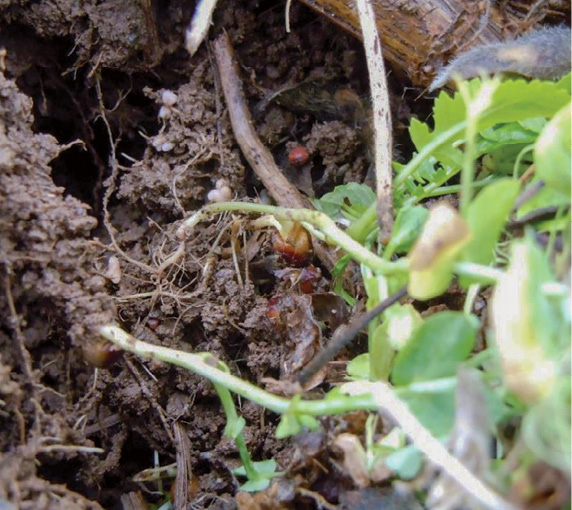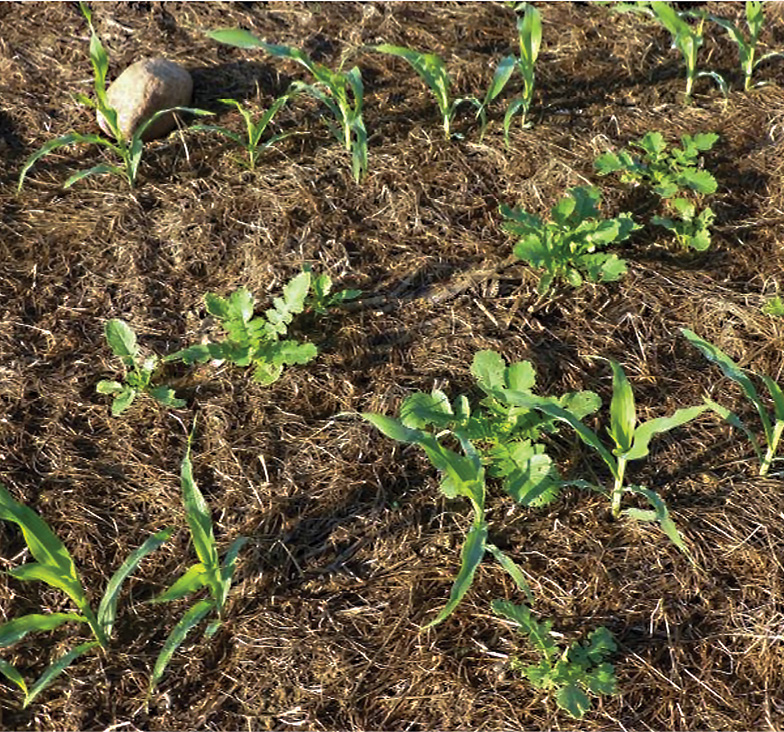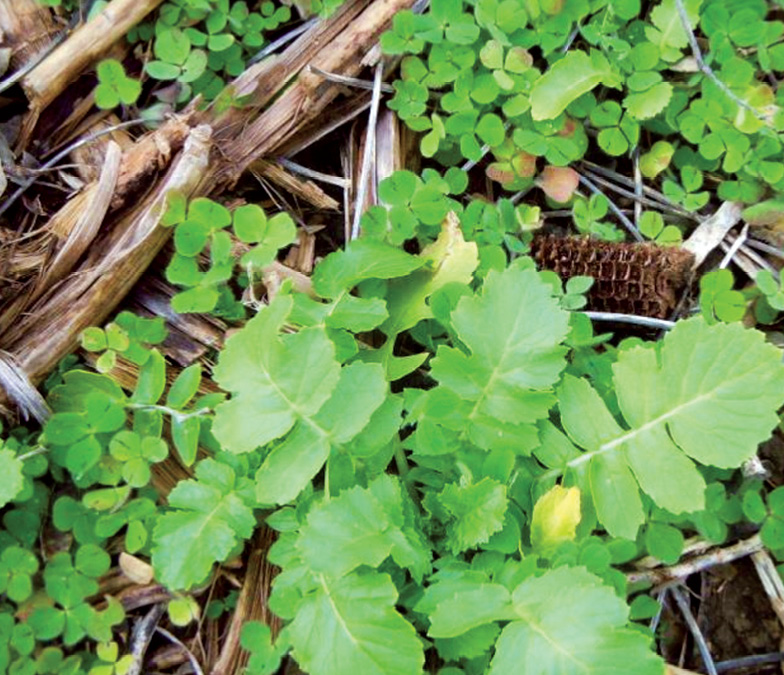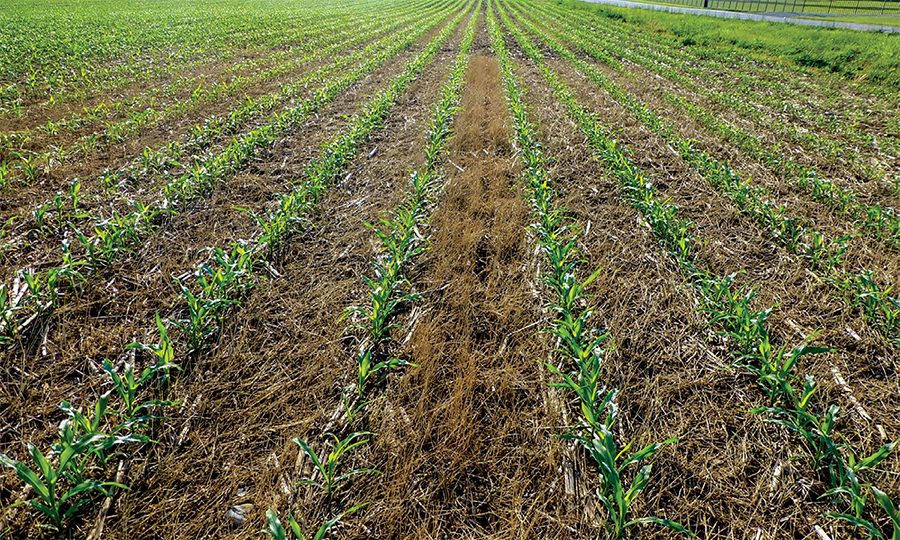Rattling off the list of cover crop benefits may require stopping for a breath of air or two to get it all out.
In recent years it’s been successfully ingrained in many farmers that cover crops can deliver in a multitude of ways, including:
Improving soil health
- Reducing erosion
- Cutting through compaction
- Increasing water- and nutrient-holding ability
- Building earthworm populations
- Improving soil aeration and percolation
- Reducing runoff and nutrient loss to groundwater
- Improving soil biology and health
- Amplifying no-till performance
“People now view this list as fact, whereas less than 10 years ago people were like, ‘Ah, I don’t know about that,’ says Dave Robison, forage and cover-crops manager for Wisconsin-based Legacy Seeds.
Some skepticism might be warranted due to a lack of data at the time. Great strides are now being made in cover-crop research, but those curious about the profitability of cover-crops are still out there — which included Robison’s own brother, Don.
It was only a matter of time before Don posed a question to his brother about cover crops: “So what if we have more earthworms? So what if we reduce compaction some? We’ve been no-tilling some of these fields for 30 consecutive years, how much benefit can we really gain?” he asked.
The really big question he posed, Robison adds, was if he could get a positive financial return from his cover-crop investment, and it’s a valid question: Many row crop-only operations want and need to know if they can get a return on a $30- to $70-per-acre cost that they don’t harvest. They also must know if they can afford the time needed to manage the extra crop.
Finding An Answer
Robison didn’t have an immediate answer to his brother’s question, so they decided to do something about it and devised a plan to do cover-crop research on the Robison family farm in central Indiana.
“We wanted to look at crop health differences, compaction differences, yield differences, and, most importantly, profit differences,” Robison says.
Tangible returns on investment are something that have been lacking in the cover-crop community.
“On my cover-crop blog I’ve received many comments from all over the world with long lists of cover-crop benefits, but nobody was telling me they were making lots more money than they ever did before.”
After harvesting the plots on their farm, every single cover-crop combination not only paid for itself, but netted modest to considerable profit per acre.
Figure 1 on page 111 shows the net-income advantage and yield increase achieved using cover crops on their farm. The term “income advantage” is defined as money earned above the control plot, minus the extra expense for cover-crop seed.
Some cover crops provided more yield response for the cover-crop seed expense in a year where drought significantly limited overall yields.
The Robison farm provided an opportunity for Robison to show the impacts cover crops can have in long-term no-till. The Robisons have been no-tilling since 1968 and owned the first Tye no-till drill in the state.
“We were some of the original trash farmers in Indiana,” Dave recalls. “There was a lot of learning going on those first years and sometimes we did not do things right. However, Dad, Don, and I knew to keep after this because caring for the soil is important.’”
In late summer 2011, Robison set about establishing a variety of cover crops in a 5-acre plot on his family farm. The brothers used over-the-shoulder-spreaders to simulate aerial applications of different cover crops and cover mixes — an unpleasant and back-breaking task, they report. The crops were seeded into standing soybeans.
Robison planted annual ryegrass; annual ryegrass with crimson clover and radish; Austrian winter pea, radish, oats, rye and Appin turnips; crimson clover and radish; oats, radish and annual ryegrass; winter cereal rye; and a 7-way combination including annual ryegrass, cereal rye, crimson clover, radish, oat, Austrian winter pea and Appin turnips.
“After 8 weeks we had a very good stand and good growth with all the cover crops,” Robison says. “We even had a good stand of Austrian winter peas with good nodulation, despite the fact that we broadcast them on top of the ground with soybeans. That’s something I wouldn’t normally recommend, but we were very fortunate to have good fall moisture.”
The Austrian winter pea, crimson clover and Appin turnips overwintered and were growing aggressively when sprayed at burn down. The same went for the Winter cereal rye and annual ryegrass.
The Results
The first factor they observed was spring weed control.

“We had virtually perfect weed control,” Dave says, thanks to the mat created by the burned-down cover crops. They did have to manage a few annual-ryegrass escapes and a few dormant radishes that popped up from seed.
All the cover-crop plots and the control plot were treated the same other than the cover crops planted. Corn was planted at 32,000 population across the plots and they all received 175 units of nitrogen and the same herbicide applications. The covers were burned down in the spring prior to planting.
During the trials they experienced severe drought. The area received just above 2 inches between May 1 and July 31, with most of that moisture coming before July 19.
There were 42 days over 90 F and 8 days over 100 F. While this was bad for crops, it allowed Robison to get a good look at how cover crops can contribute to yield under less-than-ideal conditions. This resulted in some extreme differences in yield, which he explains won’t be the case every year.
“We were primed for cover-crop success with 30 years of no-till and a dry year. Don’t expect a miracle the first year, but look for one,” Dave says. “There are cases and conditions where yields have been negatively impacted by cover crops, but for most of the work I’ve done the results have been positive and have come after only 1 year.”
So what contributed to the yield advantage in 2012? Some clues are in the Robisons’ test results.
A Bit Dense
Once the crops were up and growing, Don Robison grabbed a soil penetrometer and headed to the field to evaluate compaction.
“We know that no-till alone may not reduce compaction,” Dave says. That was proven out when he took the penetrometer to the control plot in his father’s 30-year no-till field. At about 9 inches they encountered a very bad compaction zone.
Most of the cover crops and cover mixes reduced compaction in the soil. The exception was the oat-and-radish mix, which didn’t survive the winter. The oats winterkilled at 6 to 8 inches tall and the radishes achieved decent depth before they winterkilled, but it didn’t seem to have much impact on compaction.
“This is a fairly common treatment people use when they want the cover crops to die during the winter,” Dave says. “That may not always be a good option if compaction alleviation is the main goal.”
The best results were achieved with crimson clover and radish, and with Austrian winter pea and radishes. In both cases, the companion to the radishes, peas and clover survived the winter.
“Don could put the penetrometer into the soil the full 25 inches deep in those two plots,” Robison says.
There was also an excellent result from the oats, cereal rye and Appin turnip mix, with the penetrometer surpassing 20 inches. These three mixes also topped the yield and net-profit charts — a fact that may be linked directly to getting water past that compaction layer in a summer where heat was plentiful and moisture was lacking.
“One big reason we got better yields in our plots is improved water infiltration during drought conditions,” Dave says.
Prior observations seem to prove Robison’s point. One September the Robison farm received a 3-inch rain after a very dry year.
Despite the soil being very thirsty, there was water standing on the surface in a tilled field with no cover crop. It only infiltrated a ¼-inch, with the rest evaporating or running off. This field had actually been no-tilled for 23 years before it was mistakenly tilled by an employee. That’s how much difference 1 year of tillage can make, Robison says.
In a cover crop plot at the end of the same field on Robison’s farm the rain infiltrated 3 inches deep in a field that had been consecutively no-tilled for 23 years. Digging a rogue radish growing in the field showed that its root also narrowed at 3 inches, indicating the likelihood of a compaction layer.
In the cover crop plot in that same field on their farm, this one with 1 year of a cereal rye cover crop, the water infiltrated at least 7 inches deep. Dave didn’t dig any deeper to see how far it really went.
“If that rain would have occurred in July or August, my yield would have been out-of-sight better where we had the cover crop vs. no-till alone or one year of tilled soil,” Dave says.
With cover crops, Robison has found that no-tillers get much better infiltration and percolation of water through their soils. The soil is basically becoming a sponge, he says. More moisture is taken in and crop roots grow deeper to access more moisture.
“We’re able to access nutrients that are much deeper in the soil that are not otherwise available,” he says.
Looking Green
As the season progressed, Don found more signs that the cover crops were positively impacting the corn in his plots.

He used a chlorophyll tester to determine crop health: A reading of 41 indicates a good, healthy corn plant. Keep in mind that all of the plots and the control received the same nitrogen application.
Chlorophyll readings were taken once a week starting June 20 — well into the drought.
“When we started testing, the corn was a lot healthier where we had cover crops, especially with the mix of Austrian winter peas and radish,” Robison says. The check was clocking in between 34 and 36 on the chlorophyll meter, while the pea-radish-mix corn was maintaining above the 41 standard that indicated a healthy plant.
The check only caught up with the cover-crop mix after a 1¼-inch rain in late July, but then dropped back while the cover-crop-mix corn improved again.
“This showed us that lack of moisture and heat was really keeping our corn under a great deal of stress,” Dave says. “Which most people would assume. But it also let us know that where we had the cover crop we had a whole lot less stress.”
There were similar results with all other cover-crop plots with the exception of the annual ryegrass, crimson clover and radish plot. It was equal with the check.
During this same time, June 20 through July 26, Don also measured corn height. The corn was both taller and darker green than the check in every single cover-crop plot.
“Generally speaking, this is pollination time so it’s really important to have as healthy of a crop as possible during that time period,” Robison says. “We were healthier with the cover crops on just about everything.”
And it seems to have mattered when looking at the yield results. The plots with the least compaction, and that rated the healthiest as per chlorophyll and height evaluation, also yielded the best.
“The plots with annual ryegrass did not fare as well as some others in this drought year, but were still considerably above the check,” Robison notes.
He also observed that while some of the radish plots didn’t do as well that two of the top three yielding plots had legumes plus radishes.
“Plots with legumes were generally healthier all season long and their yield reflected that,” Robison says.
Pitfall Or Profit?

Dave says he found considerably more earthworm activity in the cover-crop plots than in the 30-year no-tilled field, where there was almost no earthworm activity.
Corn roots were more robust in the cover-crop plots than the check plot, and there was more moisture in the soil, Dave says. This brings us around to the question his brother Don initially posed, “So what?”
The answer comes in the form of yields. The check plot yielded 105 bushels per acre for corn, with the entire field averaging 107 bushels per acre. The cover-crop plots all showed a yield advantage that ranged from 15 to 59 bushels more than the check plot.
Despite winterkilling and not alleviating much compaction, the oat-and-radish mix still helped boost corn yields 29 bushels. And where legumes were in the mix, yield advantages ratcheted up to 48 to 60 bushels per acre.
“Yields were down this year. Two years prior, the field produced 198-bushel corn, so it’s a good farm and we have good soil,” Don says. “The drought really took a lot out of our crop, but where we had cover crops we only took a yield hit of about 30 bushels per acre instead of almost 100 bushels per acre. That’s very significant.”
Once they took their extra yield at $6.50 corn, subtracted out cover-crop seed cost and $14 per acre for application, the smallest return on investment during this drought year was $41.78 an acre. The highest return, $286.94 an acre, came with Austrian winter peas and radish.
“Dad went from skeptical to ‘wow.’ He only allowed us 5 acres to experiment with that first year. This year, every acre of our farm has cover crops,” Dave says. “It’s really good to be able to do this research and find out some of the reasons for what we’re seeing. We found an average advantage of $150 per acre with cover crops.”
And if no-tillers want cover crops to pay even more, they should consider grazing, Dave says, adding in many years of experience. .
“There’s a lot of good money in cattle right now and cover crops can really extend the grazing season,” Dave says. “With cover crops, fields see less compaction than when grazing stalks alone and the gains are great.
“In one situation, a mix of oats, turnips and cereal rye were seeded following wheat harvest. The cattle grazed the mix all winter and gained 3-½ pounds per day without supplementing with hay.”
More Tips On Covers
Dave has been working with cover crops for years and has amassed many observations beyond what resulted from this trial.
One such note is that fields with cover crops fly in the face of the theory that no-till soils are cold.
“I’ve done close to 500 cover crop plots throughout North America in the last 5 or 6 years,” he says, noting that in the spring he packs a thermometer and does a little investigating. “Year after year I found that where there were cover crops and no-till together, the soil was always warmer than fall-tilled soil or bare soil.”
In spring 2013, Dave asked his brother, Don, to look at soil temperatures. He found that on average his no-tilled soils with covers were 2 F warmer than fall-tilled soils next to or across the road from his fields. The cover-cropped soil was about the same temperature as Don’s lawn, too.
“What greens up first in the spring? The lawn, right?” Robison asks. “That’s basically no-till and long-term cover crops, so it makes a little sense.”
He explains that spring precipitation is better managed in lawns, and with no-till with cover crops, because there’s more root mass helping make the soil like a sponge to absorb water instead of letting it sit on the surface.
Robison isn’t alone in his findings. According to the Sustainable Agriculture Research and Education Cover Crop Survey for 2012-13, corn planted after cover crops had a 9.6% increase in yield compared to side-by-side fields with no covers in fall 2012.
Soybean yields were improved 11.6% following cover crops, the survey found.
In the hardest-hit drought areas of the Corn Belt, there was an 11.0% yield increase for corn and a 14.3% increase for soybeans. This compares to Robison’s findings of a 15% to 57% increase in corn yields under drought conditions.
“Will it always work that well? No,” Robison says. “That was a drought year. It was a terrible year. But the answer is ‘Yes, cover crops can pay, even in long-term no-till.”






Post a comment
Report Abusive Comment